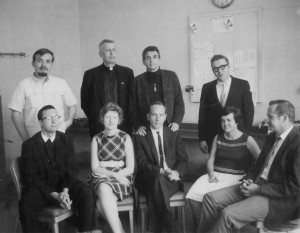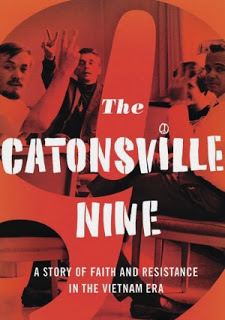Book Review: The Catonsville Nine: A Story of Faith and Resistance in the Vietnam Era by Shawn Francis Peters
The Catonsville Nine protest has often been described as one of the most significant pacifist protests of the Vietnam War era, or, in the words of the actor Martin Sheehan, “arguably the single most powerful antiwar act in American history.” But was it nonviolent, and why should it matter to ask?
All of the Nine were catholic clergymen or laity and took their inspiration, as they said, from the Sermon on the Mount, Vatican Council II, and the recent encyclical of Pope Paul VI, Populorum Progressio (“On the Development of Peoples”). They were grounded in the Christian pacifism of Tolstoy and Dorothy Day, and influenced by the social message and call to action of Liberation Theology.
As Shawn Francis Peters writes in his arresting history, The Catonsville Nine (Oxford University Press, 2012), “They framed their protest as a call to rouse their church from its slumber regarding peace and social justice issues.” And as one of the Nine, Tom Melville declared, “Our church has failed to act officially, and we feel that as individuals we’re going to have to speak out in the name of Catholicism and Christianity.” The protest action was rich in symbols; it resembled a ritual. As they set fire to the nearly 400 draft files with their own homemade napalm, they spoke of the flame as “more than a mechanism for destroying the draft files. It was an enduring Christian symbol that evoked Pentecost.” Daniel Berrigan prayed that the flame would “light up the dark places of the heart, where courage and risk were awaiting a signal, a dawn.”
The Nine included three former Maryknoll missionaries recently returned from Guatemala (John Hogan; Marjorie and Tom Melville); an artist (Tom Lewis); Fathers Phil and Daniel Berrigan; Brother David Darst; a nurse who had done mission work in Africa (Mary Moylan) and the founder of a radical Catholic community in Washington D.C. (George Mische). It was the autumn of 1968, five years after the Council. Gustavo Gutierrez’s liberation theology was raising controversy in church circles. The U.S. was divided, reeling from political assassinations, and torn by the Vietnam War. The Nine’s statement and press release, both largely written by Phil Berrigan, said that their action reflected, as Peters paraphrases it, “the values of liberation theology (against) the excesses of imperialism and the worldwide subordination of the underclass.” To these dissenters, the hierarchical church too closely resembled a secular government disaffected from the people. The Nine could no longer keep silent. They felt compelled to give witness “to the gospel of peace and love,” act to stop the War and awaken “the conscience of the Church.”
Their plan was to walk into a Selective Service center in a quiet suburb of Baltimore, stuff as many draft files as they could into metal wicker baskets, take them to a parking lot behind the center and burn them with napalm. They had chosen this center because the parking lot was isolated and no structures or people would be at risk from the fire. As Mische explained, they hoped that “completely destroying draft records, not just defacing them, could slow down the draft and thereby impede the war in Vietnam.” As they stood over the burning files and the police did not immediately arrive, Mary Moylan noted, “We thought, My God, they’re not going to arrest us; what are we going to do?” And when the police arrived and they were arrested, as Tom Melville said, there was relief “that it (had) come off the way we planned it.” Their witness, of course, was to be arrested and make of their trial a moral platform to indict the war, the government and their church, a witness consistent with the Gandhian principle of acceptance of suffering and punishment for acts of nonviolent civil resistance, although the Nine did not state this.

(l to r-top) George Mische, Philip Berrigan, Daniel Berrigan, Tom Lewis. (l to r-seated) David Darst, Mary Moylan, John Hogan, Marjorie Melville, Tom Melville.
Their lawyer, William Kunstler, based their case on the claim that burning the draft files was not a criminal act because none of the defendants intended to commit a criminal act. Rather, their intent was to prevent the murder of innocent people and the expansion of an illegal war. Their intention was to prevent a crime or crimes. The prosecution was to argue more successfully that the Nine intended to destroy government property and that destroying government property was a criminal act. As evidence against them there were not only eye witness accounts, that of the employees in the Selective Service office for example, but there were the statements of the Nine “confessing” that they had planned their action; they made the napalm in one of the Nine’s basements, scouted various sites, and deliberately picked Catonsville. None of them were to deny any of this, or would have wanted to. Intent was also the focus of Judge Thomsen’s instructions to the jury; it had a narrow legal meaning and they must make their decision based only on the narrow legal definition. Thomsen did allow the defendants to use his court to make their moral arguments, so it could be said that the trial fulfilled the Nine’s real intention, to give moral witness. The Nine were found guilty. Art Melville, Tom’s brother, was sitting in the courtroom and as the verdict was read out he shouted, “Members of the jury, you have just found Jesus Christ guilty!”
On the first day of the trial, 4 October 1968, about 2000 protesters, including this writer, marched through Baltimore in support. For the most part, as Peters reports, the march was peaceful, but some, such as Father Egan, were upset by the hatred and verbal abuse of some bystanders. There was a good deal of divided opinion about the protest in the media, in Congress, and in the church hierarchy. Peters’ book excels in laying out these agreements and disagreements, some of which were to surprise even the Nine. They had expected, for example, that at least some of the employees of the Selective Service office would see the moral logic of their action and support them, or at least stand aside to let it happen. But they resisted. One woman physically tried to restrain them and her arm was scratched, much upsetting Phil Berrigan.
Opinion was also divided within the nonviolent and pacifist movements. The most moving disagreement came from Thomas Merton. One of the great opponents of the War, he was also a close friend of both Berrigans. And he put the question to them whether the destruction of property not one’s own could be nonviolent. In a letter to another friend Merton wrote, “I don’t agree with their methods of action,” and in a published piece only weeks after the protest he called for the action to be scrutinized because it seemed to present “a new borderline situation: as if the peace movement . . . were standing at the very edge of violence.” Merton’s most trenchant remark might be that, “for nonviolence to be effective (it) has to be extremely careful and clear.”
The Berrigans also considered themselves Catholic Workers. Peters does not give us Dorothy Day’s reaction to the debate on destruction of property, but she did speak out clearly. In her essay, “Dan Berrigan in Rochester” she states, “The Catholic Worker takes the position of the War Resisters, Quakers and Fellowship of Reconciliation peace groups in not taking part in these actions of destruction of property, on the principle that, although it was only property which suffered destruction, we ourselves have suffered violence, vandalism by hostile right-wing groups, the beating of individuals, the destruction of mailing lists and records, the burning of houses and barns, etc. So we repeat the golden rule, ‘Do unto others what you would have them do unto you,’ and its contrary, ‘Do not do unto others what you would not have them do unto you.’ But we take this opportunity to tell Fathers Phil and Dan Berrigan, and all those who are suffering imprisonment now, that not a day goes by that we do not think of them, and hold them in our prayers.” Her statement is, of course, double edged: to state your disagreement does not mean to withdraw your love and support.
Doubts persist. When Gene Sharp catalogued and published his influential list of 198 methods of nonviolent protest he listed destruction of one’s own property but did not list destruction of the property of others. In George Lakey’s influential Global Nonviolent Action Database, a record of nearly 700 nonviolent campaigns, there is no mention of Catonsville.
The trial was not the end of the drama. Both of the Berrigans, and Mary Moylan went into hiding, Moylan for many years. When Daniel Berrigan was arrested on Block Island he again seized the opportunity to speak out against the war. Later, he co-authored a play called The Catonsville Nine, and a film was made of it produced by Gregory Peck. The remark of the actor and peace activist Martin Sheehan bears repeating, that Catonsville was “arguably the single most powerful antiwar act in American history.” And when Peck aired the film privately for the left-wing Greek film director Costa-Gavras, the director called the protest, “a great act of moral courage,” a judgment that somehow seems on balance the most accurate.
Peters’ book is a multi-layered account. He grounds his book in biographical sketches of each of the Nine. He was also born in Catonsville and as a child heard a great deal about the protest, and later, as a journalist and historian, it haunted his interests. The book can be read not only as an account of an historical event shaping American history, but of an event shaping the consciousness of an historian, as a kind of meta-history. It is a deeply moving if disturbing book about a country divided by war, of a church struggling with its social role under the impact of Vatican Council II, of a peace and nonviolent movement questioning tactics, and of an historian/writer growing up in the midst of social foment and later trying to come to terms with it all. Peters book raises the bar for histories of contemporary events, just as it raises questions about American militarism, American society, the social role of the Church, and the ways in which the pacifist and nonviolent movements must find common, tactical ground, questions which are still much argued, if little resolved.
EDITOR’S NOTE: Joseph Geraci is the director of the Satyagraha Foundation for Nonviolence Studies, and editor of this website. He was in the editorial collective of The Catholic Worker newspaper at the time of Catonsville and participated in the Baltimore demonstration. His last two novels are The Deaf Mute Boy (University of Wisconsin Press) and The Path of the Gods (Strand Publishers, London). See his author’s page for further information and a list of his articles posted here.





